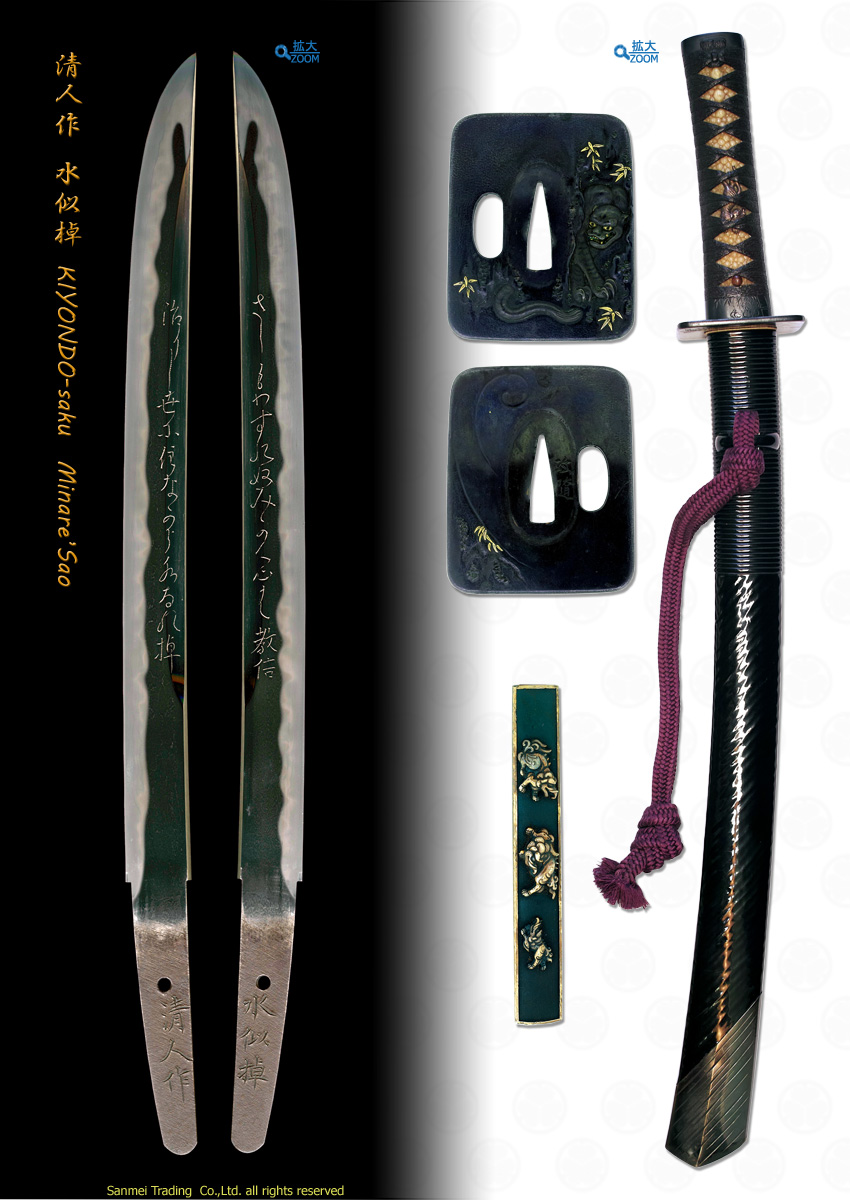with)Kuro'ro-iro lacquered waist Kizami/Samidare summer rain notches Denchu style Koshirae
Sayagaki written by Dr. Sato Kanzan "Minare'Sao"
reported in the book of
Buzen-no-kami Fujiwara KIYONDO
Length of cutting edge 29.3cm Curvature 0.3cm Width of base 29.3mm Thickness of base 7.0mm
Carvings : There is a carving of Tanka poem in front 「治りし世に住みながら水なれ棹」 "Swim with the tide pushing with an adaptable long pole (against the bottom of river)" and the other side is 「さしもわすれぬみがく心は 教信」 "Nevertheless won't forget devoting myself to go practice" by poet "KYOSHIN".(click HERE for higher resolution image of the entire blade)
Forging(Hada): Forging is fine Itame-hada mixing with some indication of Masame-hada ware and is covered with thick, sparkling hard metal granules Ji-nie on Hira-ji surface. Darkish thick Nie lines of Chikei activity gushes out clearly.
Temper(Hamon): Hamon is rather stronger side Nie hard metal granules base, Gunome and tassel-shaped Choji with indication of Togari-ha. Boundary line of Habuchi is covered with sparkling quench crystalline area add like a pearl luster impression with extreme deep Noi mist-like crystalline area. In the interior of temper, there works frequently with long Kinsen bright threadlike areas and Sunagashi long lines of Nie. Thick NieGunome-ashi feet frequently splashes into the cutting edge. Those activities of quench state are extremely vivid and bright standing out strikingly.
Temper of tip(Boshi): Boshi forms Midarekomi irregular quench state with an intense Hakikake blush up indication and small circle turns back.
Tang(Nakago): Nakago is in UBU original. One Mekugi-ana punch. Sujikai (slanting left) filemarks. Back ridge of Nakago is a bit well-rounded contour with Sujikai filemark. Bottom shape is double bevelled Kurijiri in full. The signature performed in front is chiselled as KIYONDO-saku 清人作 the other side is chiselled with pseudonym words Minare'Sao 水似棹 - an adaptable long pole (against the bottom of the river).
Saito KIYONDO 斎藤清人 was born in Bunsei 10 (1827), childhood name Saito Ko'ichiro 斉藤小市郎 at Taki-no-ya Inn with hot springs (now Yuatsumi, Tsuruoka city, Yamagata pref.). A little short while he was adopted to his uncle Koto Kin'ju-ro 事金十郎 of Asahiya Inn in the same spa town Yuatsumi.
He learned sword making from his foster-father Koto Kin'ju-ro and went up to capital Edo in Kaei 5 (1852) to take further lessons in earnest to be a pupil of famed smith KIYOMARO 清麿 who won the highest praise as Yotsuya MASAMUNE 四ッ谷正宗 when he was 26 years old. He had a good personality of honesty in good faith and enjoyed his master's confidence in his skill and fostered mutual trust.
However master MIYOMARO 清麿 met a sudden death being heavily in debt Kaei 7 (1854). Although other pupils made an escape from his debts, only KIYONDO 清人 cleared off all debts from master KIYOMARO 清麿 by making swords in Shoushu tradition. He has been therefore admired as a person of great nobility until today.
After a restoration of Ansei-Edo earthquake in Ansei 2 (1855) he set his atelier at Ogawa-town, Kanda then in Ansei 5 (1858) he was nominated as an exclusive sword maker from feudal lord Sakai in Shōnai domain with reward for 5 fuchi and enjoyed Buzen-no-kami 豊前守 title in Keiou 3 (1867).
This superior wakizashi is one of his masterpieces on about Ansei 4 (1857) - judged from inscription manner when he was matured around 30 years old, 2 years later from KIYOMARO's death - made in his own atelier while he struggled to make the swords of Soushu tradition to clear debits on behalf and guess to make out skilled carvings of poem from a customer's favor.
This wakizashi is reported in the book of Buzen-no-kami Fujiwara KIYONDO, Otsuka-kogei-sha, 1972 and comes with an original superb Chi'sa katana style mounting.
with) Kuro-ro-iro lacquered waist Kizami/Samidare summer rain notches Denchu style Koshirae
(click HERE for entire Koshirae and HERE for each fitting)
- Tsuba : Tiger/bamboo leaves design, Shakudo ground Takaniku/Sukibori carving, Gold Iroe signed Shouzui 政随
- Menuki : Tiger design Yamagane copper ground Yobori carving
- Kozuka : Shishi parental lions design ShakudoNanako-ji ground Takabori unsigned
- Tsuka : white rayskin, brown lacquered lozenge wrapped
- Kojiri : Denchu style Samidare rain notches design
reference data : Igarashi Zenshiro, Buzen-no-kami Fujiwara KIYONDO, Otsuka-Kogei-sha, 1972

